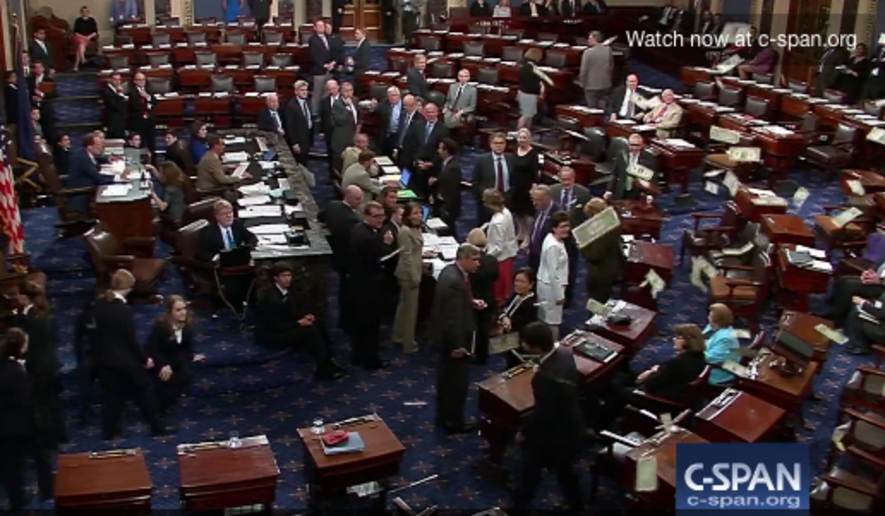Democrats have the momentum, the energy and the enthusiasm of an extraordinary number of new candidates as the 2018 congressional election season appears on the horizon. But Republicans have demographics and geography on their side – now and in the near future.
That’s the conclusion of Dave Wasserman, a Cook Political Report editor, who has crunched the numbers and found that the Democrats’ chances of retaking the House next year are rather slim, and their hopes for making gains in the Senate any time soon are nearly foolhardy.
The reasons are many: the GOP dominance of state legislatures and the subsequent gerrymandering of House districts; the growing number of straight-ticket voting; the dissension within the Democratic Party that has resulted in a distinctive tilt to the left, with an emphasis on urban issues and identity politics; and the Dems’ utter lack of competitiveness anywhere in rural America.
That last factor is particularly powerful in terms of future Senate elections.
Compared to the presidential election year that marked the GOP resurgence in Congress, the 1980 win for Republican Ronald Reagan over Democratic incumbent Jimmy Carter, the decline in swing states has changed the election map markedly.
In 1980, a party seeking control of the Senate over three election cycles had to hold onto their “friendly” states and win at least 15 of 28 swing state seats.
Heading into ’18, the Republicans don’t need to capture any swing states to maintain a Senate majority, according to Wasserman. Fifty-two seats are in states where the 2016 presidential margin was at least 5 percentage points more Republican than the national outcome. By contrast, there are just 28 seats in states where the margin was at least 5 points more Democratic, and only 20 seats in swing states.
In a piece written for FiveThirtyEight, Wasserman offered this assessment:
The Senate hasn’t had such a strong pro-GOP bias since the ratification of direct Senate elections in 1913.
Even if Democrats were to win every single 2018 House and Senate race for seats representing places that Hillary Clinton won or that Trump won by less than 3 percentage points — a pretty good midterm by historical standards — they could still fall short of the House majority and lose five Senate seats.
This is partly attributable to the nature of House districts: GOP gerrymandering and Democratic voters’ clustering in urban districts has moved the median House seat well to the right of the nation. Part of it is bad timing. Democrats have been cursed by a terrible Senate map in 2018: They must defend 25 of their 48 seats while Republicans must defend just eight of their 52.
What’s more, Democrats tend to forget that their congressional victories in 2006 and 2008 were not part of a trend, they were the result of a perfect storm that swamped the GOP. The unpopular war in Iraq, the botched response to Hurricane Katrina, and the deepest recession since the Great Depression provided electoral opportunities for the Dems that could not have been imagined just a half-decade earlier.
An unprecedented opportunity also arose – the prospect of electing the nation’s first black president — and it produced a hope-and-change tenor of goodwill, a bit of an ‘08 coattail effect, with some Republican moderates siding with Barack Obama.
But in 2016, the nation’s urban/rural, working class vs. white collar divide became overwhelming. California and New York, with their massive urban centers, combined to give Hillary Clinton a 6 million vote edge, more than twice her overall national margin, Wasserman notes. But those two states elect only 4 percent of the Senate. At the same time, Republicans have enjoyed huge gains in small rural states such as Arkansas, North and South Dakota, Iowa, Louisiana, Montana and West Virginia. The result is a disproportionate show of power in the Senate compared to their rather meager populations.
Some political analysts say that the changing demography and geography is working in such a profound manner that the GOP dominance in the country’s broad midsection and the concentration of Dems in flourishing cities on the two coasts will intensify to such an extent that the entire concept of a democratic (small “d”) Senate could implode.
Political scientist David Birdsell projects that economic forces over the next three decades will result in 70 percent of Americans living in the 15 largest states, which are home to the overwhelming majority of the nation’s 30 largest cities. At the same time, 30 percent of Americans will live in the other 35 states where good-paying jobs will be hard to come by.
What does all that mean? On election night in 2040, some 70 percent of Senate seats could be occupied by senators who represent just 30 percent of the U.S. population.









